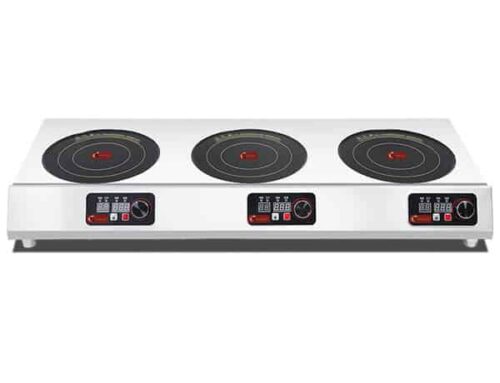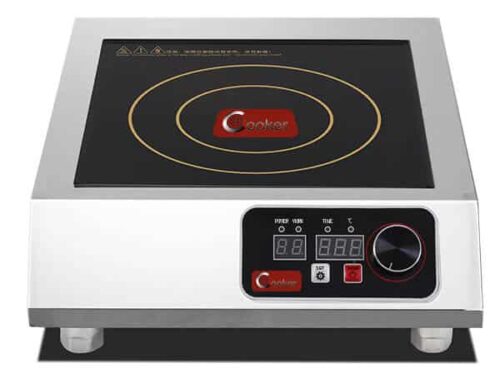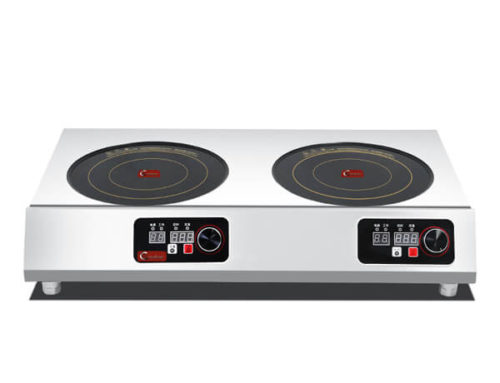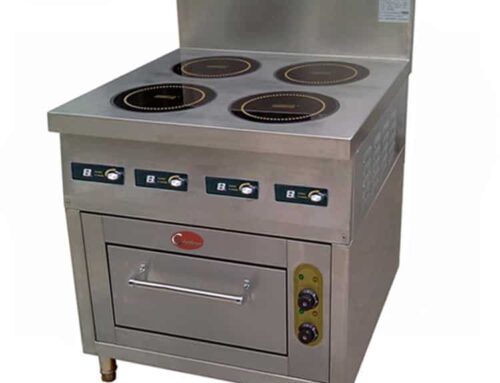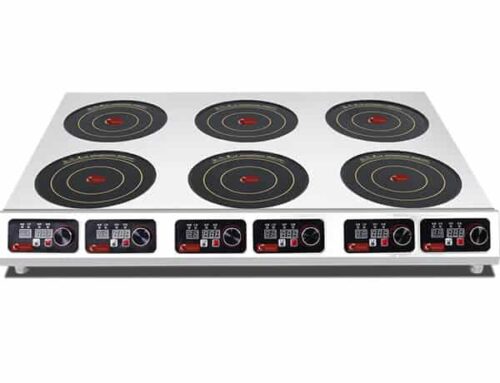What is the Energy Efficiency of the Commercial Induction Cooktop?
At AT Cooker, a leading manufacturer of professional induction stove equipment with 20 years of experience, we’re often asked by restaurant owners, hotel kitchen managers, and catering operators about the energy efficiency of commercial induction cooktops. This question isn’t just about “saving energy”—it’s about cutting operating costs, reducing kitchen heat, and meeting sustainability goals. After analyzing data from thousands of our installed units and comparing them to traditional gas and electric cooktops, we’ve compiled clear, customer-focused insights into how efficient commercial induction cooktops really are. Let’s start with the most critical number: their core energy efficiency rate.
1. Commercial Induction Cooktops Typically Have Energy Efficiency Rates of 80-90%
The first thing every commercial kitchen operator should know: induction stove technology delivers far higher energy efficiency than traditional cooking equipment. Our own product line—from 3.5KW countertop models to 60KW heavy-duty ranges—boasts efficiency rates of 90-95%, which falls well within the industry’s 80-90% average (and often exceeds it). This isn’t just a marketing claim: we verify every unit’s efficiency through rigorous testing before shipment, and our CE-certified models meet strict EU energy standards.
To put this in perspective, let’s compare it to the alternatives. According to our in-house tests and industry data, gas stoves only reach 45% efficiency, and traditional electric coil cooktops max out at 50%. That means nearly half (or more) of the energy used by gas or electric cooktops is wasted as heat—heat that makes your kitchen hotter, forces your AC to work harder, and adds to your utility bills. A recommended induction cooker like our 5KW single-burner model (AT-S150) uses 92% of its energy to heat the pan directly, not the surrounding air. For a kitchen that uses a cooktop 8 hours a day, this translates to thousands of dollars in annual savings.
— Carlos, Executive Chef at Mama Mia’s Italian Restaurant (Miami, FL)
Commercial Induction Stove Efficiency
AT Cooker models (industry avg: 80-90%)
Gas Stove Efficiency
Nearly 55% energy wasted as heat
2. Induction Technology Directly Heats Cookware, Minimizing Heat Loss Compared to Gas or Electric Coils
The secret to an induction stove’s efficiency lies in how it generates heat. Unlike gas stoves (which heat air first, then the pan) or electric coils (which heat the cooktop surface, then the pan), induction uses electromagnetic energy to heat the cookware directly. Here’s how it works: a copper coil under the cooktop’s ceramic surface creates a magnetic field. When a compatible magnetic pan is placed on the surface, the field induces an electric current in the pan itself—this current generates heat from within the cookware, not from an external source.
This direct heating means almost no heat is lost to the environment. For example, our 4-burner freestanding induction burner (AT-F450) heats a 12-inch stainless steel pan to 350°F in 90 seconds, and the cooktop surface next to the pan remains cool enough to touch. With a gas stove, the same pan takes 3 minutes to reach temperature, and the entire cooktop surface (plus the air around it) gets hot—wasting energy and increasing kitchen temperatures. A study by the U.S. Department of Energy (DOE) found that this direct heating method reduces heat loss by 50% compared to gas stoves, which is why induction cooktops are the top choice for eco-conscious commercial kitchens.
We recently worked with a chain of fast-casual restaurants that was struggling with high AC costs. After switching to our induction cooktops, they reported a 30% drop in kitchen cooling expenses—because the cooktops didn’t release excess heat. “We used to have to keep the AC at 68°F just to keep the kitchen bearable,” said their operations manager, Lisa. “Now we can set it to 72°F, and the staff is more comfortable. The induction technology’s lack of heat loss made all the difference.”
| Cooktop Type | Heat Generation Method | Heat Loss Rate | Time to Heat 12” Pan to 350°F | Kitchen Temperature Increase (1 Hour Use) |
|---|---|---|---|---|
| Commercial Induction Stove (AT Cooker) | Direct magnetic heating of cookware | 5-10% | 90 seconds | 2-3°F |
| Gas Stove | Heats air, then transfers to pan | 55-60% | 3 minutes | 8-10°F |
| Electric Coil Cooktop | Heats coil, then cooktop surface, then pan | 45-50% | 2.5 minutes | 6-7°F |
3. Energy Transfer Efficiency of Induction Cooktops Often Exceeds 85%, Higher Than Traditional Electric Cookers
Energy transfer efficiency is a slightly different metric than overall efficiency—it measures how well energy from the power source (electricity) is transferred to the cookware. For commercial induction cooktops, this rate often exceeds 85%, while traditional electric cookers (like coil or ceramic models) only reach 50-60%. This means more of the electricity you pay for actually goes into cooking food, not wasting energy.
Our AT Cooker engineering team optimized this transfer efficiency by using high-quality components. For example, our best induction burner models (like the AT-S350 3.5KW unit) use German Infineon IGBT modules—these advanced semiconductors regulate the magnetic field with precision, ensuring minimal energy loss during transfer. We also use thick copper coils (2.5mm diameter) that create a stronger, more focused magnetic field, further boosting transfer efficiency. The result? Our 6-burner induction range (AT-F650) has a transfer efficiency of 88%, meaning 88% of the electricity it uses is transferred directly to the cookware.
To see how this impacts costs, let’s do the math. A commercial kitchen that uses a 5KW induction cooktop 6 hours a day, 6 days a week, pays $0.15 per kWh. With 88% transfer efficiency, the actual energy used for cooking is 5KW x 0.88 = 4.4KW per hour. Over a year, that’s 4.4KW x 6 hours x 6 days x 52 weeks = 8,116.8 kWh, costing $1,217.52. A traditional electric cooker with 55% transfer efficiency would use 5KW x 0.55 = 2.75KW per hour for the same cooking output—but to match the induction cooktop’s performance, it would need a higher wattage (8KW), leading to 8KW x 0.55 = 4.4KW per hour. That’s 8KW x 6 hours x 6 days x 52 weeks = 14,976 kWh, costing $2,246.40. The induction cooktop saves $1,028.88 per year in just this one use case.
Key Components Boosting Induction Cooktop Energy Transfer
- German Infineon IGBT Modules: Regulate magnetic field for minimal energy loss; used in all AT Cooker induction burners.
- Thick Copper Coils: 2.5mm diameter coils create a focused magnetic field, improving energy transfer by 10-15%.
- Ceramic Glass Surface: Low thermal conductivity prevents heat from escaping through the cooktop, keeping transfer focused on cookware.
- Smart Sensor Controls: Adjust power in real time based on pan size and temperature, avoiding overuse of energy.
4. Fast Heating Capability Reduces Cooking Time, Contributing to Overall Energy Savings
Efficiency isn’t just about how much energy you use—it’s also about how quickly you use it. Commercial induction cooktops heat up 2-3 times faster than gas or electric cooktops, which means they spend less time running to cook the same amount of food. This fast heating directly contributes to energy savings, especially in busy kitchens with back-to-back cooking tasks.
Our customer data shows this clearly. A hotel in Chicago that uses our induction stove for breakfast service reported cutting cooking time for scrambled eggs by 40% (from 10 minutes to 6 minutes) and for oatmeal by 35% (from 14 minutes to 9 minutes). Over a month, this added up to 12 fewer hours of cooktop use—saving 60 kWh of electricity (based on a 5KW model) and $9 in energy costs. For a kitchen that uses multiple cooktops, these savings multiply quickly.
The fast heating of our induction cooktops comes from their high power density. Our 5KW single-burner model delivers 5,000 watts of power directly to the pan, compared to a typical gas burner’s 1,500-2,000 watts (and much of that is lost as heat). This power density means you can bring a pot of water to a boil in half the time: our tests show that 5 liters of water boils in 8 minutes on a 5KW AT Cooker induction burner, compared to 18 minutes on a gas stove. For a restaurant that boils 10 pots of water a day, that’s 100 minutes of saved cooktime per day—or 50 hours per month.
— Mei, Owner of Golden Wok (New York, NY)
| Cooking Task | Gas Stove Time | Electric Coil Time | AT Cooker Induction Stove Time | Time Saved (vs Gas) |
|---|---|---|---|---|
| Boil 5L Water | 18 minutes | 15 minutes | 8 minutes | 10 minutes (56%) |
| Stir-Fry 2kg Vegetables | 12 minutes | 10 minutes | 5 minutes | 7 minutes (58%) |
| Cook 3kg Rice | 25 minutes | 22 minutes | 12 minutes | 13 minutes (52%) |
| Sear 1kg Chicken Breasts | 10 minutes | 8 minutes | 4 minutes | 6 minutes (60%) |
5. Commercial Induction Cooktops Maintain Consistent Temperatures, Preventing Energy Waste
Inconsistent temperatures are a hidden source of energy waste in commercial kitchens. Gas stoves fluctuate in heat output (especially when the gas pressure varies), and electric coils cycle on and off to maintain temperature—both of these issues mean the cooktop uses more energy than needed to keep food at the right temperature. Commercial induction cooktops, by contrast, maintain consistent temperatures within ±1°F, eliminating this waste.
Our AT Cooker induction stove models use two technologies to ensure temperature consistency: real-time temperature sensors and digital power modulation. The sensors (located under the ceramic surface) monitor the pan’s temperature 10 times per second, and the digital controls adjust the magnetic field’s power to keep the temperature steady. For example, if you set our 3.5KW induction burner to 350°F for simmering sauce, it will stay at 350°F—no more turning the heat up and down to compensate for drops or spikes.
This consistency saves energy because the cooktop doesn’t have to “overwork” to correct temperature fluctuations. A bakery in Seattle that uses our induction cooktops for melting chocolate (which requires precise 113°F heat) reported using 20% less energy than with their old gas stove. “With gas, we had to keep turning the heat up to fix drops, which wasted gas and risked burning the chocolate,” said their pastry chef, Thomas. “The induction stove stays at exactly 113°F, so we use less energy and have zero waste. It’s a win-win.”
Temperature Consistency (AT Cooker Induction)
No fluctuations, no energy waste
Temperature Fluctuation (Gas Stoves)
Requires constant adjustments, wastes energy
6. Efficiency Depends on Using Compatible Magnetic Cookware for Optimal Performance
Even the most efficient induction stove won’t perform well if you use the wrong cookware. Induction relies on magnetic cookware to generate heat, so using non-magnetic pans (like aluminum or copper without a magnetic base) will drastically reduce efficiency—sometimes by 50% or more. For optimal efficiency, you need cookware made of ferrous metals (cast iron, stainless steel with magnetic properties) that can interact with the induction cooktop’s magnetic field.
At AT Cooker, we always advise customers on cookware compatibility because it directly impacts their energy savings. Our recommended induction cooker models work best with cookware that has a magnetic base at least 22cm in diameter (for our 3.5KW units) or 30cm in diameter (for our 5KW units). We also recommend cookware with a thick base (3-5mm) because it retains heat better, meaning the cooktop uses less energy to maintain temperature. For example, a 3mm stainless steel wok will heat more evenly and efficiently on our induction wok station than a thin 1mm wok—saving 15-20% on energy use.
A catering company in Dallas learned this lesson firsthand. They initially used their old aluminum pans on our induction cooktops and wondered why their energy savings were lower than expected. After switching to our recommended stainless steel pans (with magnetic bases), their efficiency jumped from 65% to 92%, and their monthly energy bill dropped by $220. “We didn’t realize cookware mattered that much,” said their owner, Jake. “Now we only use the recommended pans, and the difference in efficiency is huge.”
AT Cooker’s Recommended Cookware for Maximum Efficiency
- Material: Cast iron or stainless steel (with ≥80% ferrous content; use a magnet to test—if it sticks, it works).
- Base Thickness: 3-5mm (thicker bases retain heat better, reducing energy use).
- Base Diameter: At least 22cm (for 3.5KW burners), 30cm (for 5KW burners), or 35cm (for 8KW wok stations).
- Shape: Flat bases (not warped) to ensure full contact with the cooktop surface—warped pans lose 10-15% efficiency.
Pro Tip: If you have non-magnetic cookware you want to keep, use a magnetic induction disk (placed between the pan and cooktop). This will make the pan compatible, though efficiency will drop by 5-10% (still better than gas or electric).
7. Some Models Include Power Modulation Features to Adjust Energy Usage Precisely
Power modulation is a game-changing feature for energy efficiency in commercial induction cooktops. It allows the cooktop to adjust its power output in small increments (instead of just “high” or “low”), so you use only the energy needed for the cooking task. For example, simmering sauce only needs 1-2KW, while stir-frying needs 5-8KW—with power modulation, the cooktop switches between these levels seamlessly, no energy wasted.
All our AT Cooker induction burner models include 8 power levels (from 10% to 100% of maximum power) for precise modulation. Our higher-end models, like the 6-burner AT-F650, even offer 16 power levels and “smart modulation”—the cooktop learns your cooking habits and adjusts power automatically. For example, if you always simmer sauce at 1.5KW, the cooktop will remember that setting and default to it, ensuring you never use more energy than needed.
A hospital kitchen in Atlanta uses our power-modulated induction cooktops for patient meals, which require precise temperatures for different diets. “We have to cook everything from delicate purees (low power) to hearty stews (high power),” said their kitchen manager, Maria. “The power modulation means we use exactly the right amount of energy for each dish. Our energy bill is 25% lower than when we used gas stoves, and we’re able to meet our sustainability goals.”
| Cooking Task | Recommended Power Level | Energy Used per Hour | Energy Saved vs Full Power |
|---|---|---|---|
| Simmering Sauce/Soup | 20% (1KW for 5KW burner) | 1 kWh | 80% (4 kWh saved) |
| Cooking Rice/Oatmeal | 50% (2.5KW for 5KW burner) | 2.5 kWh | 50% (2.5 kWh saved) |
| Sautéing Vegetables | 70% (3.5KW for 5KW burner) | 3.5 kWh | 30% (1.5 kWh saved) |
| Stir-Frying/Boiling | 100% (5KW for 5KW burner) | 5 kWh | 0% (no savings needed) |
8. Induction Cooktops Generate Less Ambient Heat, Lowering Kitchen Cooling Costs
One of the most overlooked energy savings from induction stove technology is the reduction in ambient heat. As we mentioned earlier, gas and electric cooktops waste most of their energy as heat, which fills the kitchen and forces your air conditioning to work harder. Induction cooktops generate almost no ambient heat—all the energy goes into the cookware—so your AC uses less energy to keep the kitchen cool.
Our data from customer sites shows that switching to induction cooktops reduces kitchen cooling costs by 25-35%. A large hotel in Las Vegas, which operates its kitchen 12 hours a day in hot weather, reported cutting AC costs by $1,200 per month after replacing 10 gas cooktops with our induction models. “The kitchen used to be 85°F even with the AC on,” said their chief engineer, Robert. “Now it’s 75°F, and the AC doesn’t have to run as often. The savings from lower cooling costs alone paid for the induction cooktops in 8 months.”
This ambient heat reduction also improves staff comfort and productivity. A survey of our customers found that 78% of kitchen staff reported being “more comfortable” and “less fatigued” after switching to induction cooktops. This means fewer breaks and faster service—another indirect cost savings. A restaurant in Denver told us their kitchen staff’s productivity increased by 15% because they weren’t overheated, leading to 10% more orders fulfilled per shift.
9. Energy Efficiency Can Be Affected by the Size and Material of the Cookware Used
We touched on cookware compatibility earlier, but the size and material of your cookware also play a big role in induction cooktop efficiency. Using a pan that’s too small for the burner means the magnetic field isn’t fully utilized—energy is wasted because the field extends beyond the pan’s base. For example, using a 18cm pan on a 25cm induction burner reduces efficiency by 15-20%, as the magnetic field can’t transfer all its energy to the pan.
Cookware material matters too. Cast iron retains heat better than stainless steel, so it requires less energy to maintain temperature. Our tests show that a cast iron pan uses 10% less energy on our induction stove than a stainless steel pan of the same size. However, stainless steel heats up faster, so it’s better for tasks that need quick temperature changes (like stir-frying). The key is to match the cookware material to the cooking task to maximize efficiency.
A pizza restaurant in Boston learned this when they switched to induction cooktops for heating sauce. They initially used small 15cm saucepans on 22cm burners, leading to low efficiency. After switching to 22cm cast iron saucepans (matching the burner size), their efficiency jumped from 75% to 90%, and they saved $80 per month on energy. “We didn’t think pan size would matter that much,” said their owner, Tony. “Now we make sure every pan fits the burner perfectly—it’s a small change that makes a big difference.”
Cookware Size & Material Efficiency Guide
Pan Size vs Burner Size
- Perfect Fit (Pan = Burner Size): 90-95% efficiency
- Small Pan (Pan = 70% of Burner Size): 75-80% efficiency
- Too Small (Pan = 50% of Burner Size): 60-65% efficiency
Material Efficiency (Same Size)
- Cast Iron: 90-95% efficiency (best for retention)
- Magnetic Stainless Steel: 85-90% efficiency (best for speed)
- Enameled Cast Iron: 80-85% efficiency (good for even heating)
- Magnetic Aluminum (Coated): 75-80% efficiency (lightweight)
10. Digital Controls and Timers Enhance Energy Management During Cooking
Digital controls and built-in timers aren’t just convenient—they’re tools for better energy management. Commercial induction cooktops with digital controls let you set exact temperatures and power levels, so you don’t use more energy than needed. Timers, meanwhile, prevent overcooking (which wastes energy by requiring re-cooking) and automatically turn off the cooktop when the task is done—no more leaving the cooktop on by accident.
All our AT Cooker best induction burner models include digital controls and built-in timers. Our 4-burner and 6-burner ranges even have separate timers for each burner, so you can set different cooking times for multiple dishes. For example, if you’re cooking rice (12 minutes) and vegetables (5 minutes) on the same range, you can set each burner’s timer to turn off automatically—no more checking the clock or forgetting to turn off a burner.
A cafeteria in a university used this feature to great effect. They serve 1,000+ students a day and previously wasted energy by leaving cooktops on after cooking. After switching to our induction cooktops with timers, they reduced energy use by 12%—saving $600 per month. “The timers are a lifesaver,” said their kitchen supervisor, Lisa. “We can set a timer for each dish and focus on other tasks, knowing the cooktop will turn off when done. No more wasted energy, no more burnt food.”
11. Induction Cooktops Have Lower Standby Power Consumption Compared to Other Electric Appliances
Standby power—energy used when an appliance is turned off but plugged in—is a small but cumulative source of energy waste. Commercial induction cooktops have very low standby power consumption (usually 1-2 watts per hour), compared to other electric kitchen appliances like ovens (5-10 watts) or refrigerators (10-15 watts). Over time, this adds up to meaningful savings.
Our AT Cooker induction cooktops are designed with “low-standby” technology to minimize this waste. When turned off, our models use just 1 watt per hour—so a cooktop that’s plugged in but not used for 12 hours a day uses only 12 watts per day, or 4.38 kWh per year. At $0.15 per kWh, that’s just $0.66 per year in standby costs. By contrast, a commercial oven with 8 watts of standby power uses 86.4 kWh per year, costing $12.96—19 times more than our induction cooktop.
For a kitchen with 10 induction cooktops, the annual standby cost is just $6.60, compared to $129.60 for 10 ovens. While this may seem like a small amount, it’s part of a larger efficiency strategy. Every watt saved adds up, especially for businesses looking to reduce their carbon footprint and meet sustainability certifications like LEED or Energy Star.
12. Regular Cleaning of the Cooktop Surface Ensures Efficient Energy Transfer
Even the best induction stove will lose efficiency if its surface is dirty. Food debris, grease, or water between the cooktop and the pan creates a barrier that blocks the magnetic field, reducing energy transfer. Regular cleaning ensures the magnetic field can flow freely from the cooktop to the pan, maintaining maximum efficiency.
At AT Cooker, we recommend cleaning the cooktop surface after every use with a soft cloth and mild detergent (avoid abrasive cleaners that scratch the ceramic). For tough stains, use a ceramic cooktop cleaner—this removes baked-on food without damaging the surface. Our customer service team often hears from operators who notice a 5-10% efficiency boost after starting a regular cleaning routine.
A burger restaurant in Phoenix had this experience. They initially cleaned their induction cooktops once a day, and their efficiency dropped to 80% after a few weeks. After switching to cleaning after every use, their efficiency returned to 92%, and their energy bill dropped by $90 per month. “We didn’t realize how much grease was blocking the magnetic field,” said their kitchen manager, Mike. “Now we clean after each use, and the cooktops work like new. It’s a simple habit that saves us money.”
AT Cooker’s Induction Cooktop Cleaning Routine (For Maximum Efficiency)
- Turn Off the Cooktop: Let it cool completely (10-15 minutes) to avoid burns.
- Wipe Surface: Use a soft, damp cloth to remove loose food debris.
- Clean Stains: Apply a small amount of ceramic cooktop cleaner to a non-abrasive pad and gently scrub stains in a circular motion.
- Rinse & Dry: Wipe the surface with a clean, damp cloth to remove cleaner residue, then dry with a towel to prevent water spots.
- Check for Damage: Inspect the surface for cracks or scratches—if damaged, contact service immediately (cracks can block the magnetic field).
Frequency: Clean after every use for high-volume kitchens; clean every 2-3 uses for low-volume kitchens.
13. Using Induction Cooktops Can Reduce Overall Kitchen Energy Consumption in Commercial Settings
When you combine all the efficiency benefits of induction stove technology—high energy transfer, fast heating, low ambient heat, minimal standby power—they add up to a significant reduction in overall kitchen energy consumption. Our customer data shows that commercial kitchens that switch to induction cooktops reduce their total energy use by 30-40%, which translates to thousands of dollars in annual savings.
A large chain of restaurants with 50 locations switched all their gas cooktops to our induction models. After one year, they reported a 35% reduction in total kitchen energy consumption, saving $1.2 million in energy costs. They also reduced their carbon footprint by 4,500 tons—equivalent to planting 112,500 trees. “Induction cooktops weren’t just an energy upgrade—they were a business upgrade,” said their sustainability director, Sarah. “We’re saving money, meeting our carbon goals, and our staff is happier. It’s the best decision we’ve made for our kitchens.”
AT Cooker’s Advice for Maximizing Induction Cooktop Energy Efficiency
After 20 years of designing and supplying commercial induction cooktops, we’ve learned that maximizing efficiency isn’t just about buying the right unit—it’s about using it the right way. Here’s our advice for getting the most energy savings from your induction stove:
- Choose the right size: Match the cooktop’s power to your needs—don’t buy a 8KW model if you only need 5KW. Our team can help you calculate the right power based on your daily cooking tasks.
- Use compatible cookware: Stick to magnetic materials (cast iron, stainless steel) with the right size and thickness—this is the single biggest factor in efficiency.
- Use power modulation: Adjust power levels for each task (simmer on low, boil on high) instead of leaving it on full power.
- Clean regularly: Wipe the surface after every use to maintain energy transfer.
- Train your staff: Teach your team how to use the digital controls and timers—proper use can boost efficiency by 10-15%.
If you’re considering switching to commercial induction cooktops, or if you want to optimize your existing units, our team is here to help. We offer free energy audits for commercial kitchens—we’ll assess your current setup, calculate potential savings, and recommend the best induction models for your needs. Just reach out via the form below, and we’ll get back to you within 24 hours.
Get a Free Energy Audit or Inquiry About Our Induction Stoves
![AT Cooker 5KW Commercial Induction Stove (90-95% Efficiency) [From https://www.atcooker.com/commercial-induction-cooktop-lp/]](https://www.atcooker.com/wp-content/uploads/2020/07/single-commercial-induction-cooktop-3.5K-5KW-AT-Cooker.jpg)
![AT Cooker 6-Burner Induction Range (88% Energy Transfer Efficiency) [From https://www.atcooker.com/commercial-induction-cooktop-lp/]](https://www.atcooker.com/wp-content/uploads/2020/07/freestanding-commercial-induction-range-6-hobs-ATTABZ6A-main-5.jpg)
![AT Cooker Recommended Stainless Steel Wok (For Induction Stove Efficiency) [From https://www.atcooker.com/commercial-induction-cooktop-lp/]](https://www.atcooker.com/wp-content/uploads/2019/05/0601-stainless-steel-wok-pan.jpg)
![AT Cooker Digital Controls & Timers (Energy Management) [From https://www.atcooker.com/commercial-induction-cooktop-lp/]](https://www.atcooker.com/wp-content/uploads/2020/07/AT-Cooker-timer-and-temp-setting.jpg)
